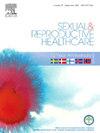Sexually transmitted infections (Chlamydia trachomatis, genital HSV, and HPV) and female fertility: A scoping review
IF 1.7
3区 医学
Q3 PUBLIC, ENVIRONMENTAL & OCCUPATIONAL HEALTH
引用次数: 0
Abstract
More than one million sexually transmitted infections (STIs) are acquired every day worldwide. They are commonly caused by Chlamydia trachomatis (CT), herpes simplex virus (HSV), or human papillomavirus (HPV) and are suggested to contribute to female infertility. This scoping review aims to map and summarize existing literature on the association between a pre-pregnancy infection with CT, genital HSV, or HPV and female fertility.
We searched two databases (PubMed, Embase) to identify published literature on the association between CT, genital HSV, or HPV infection and female fertility. We included full-text articles, published from 2002 to 2022, on pre-pregnancy infection with either CT, genital HSV, or HPV within a population of women of reproductive age. The study endpoint was either pregnancy, time-to-pregnancy, or infertility. The included studies were evaluated according to the Critical Appraisal Tool by Joanna Briggs Institute.
Eight studies were eligible for the review. All of them investigated the association between a CT infection and fertility, while none of them investigated infections with genital HSV or HPV. Three studies found that a CT infection was associated with poorer female fertility, and one study found a similar association in a subgroup analysis of women with a pregnancy intention. Four studies indicated no association, although methodological differences between the studies preclude firm conclusions.
This review revealed sparse literature investigating the association between CT, HPV, and HSV and subsequent female fertility. Prospective cohort studies with preconception assessments of these STIs are needed to determine the relation between STIs and subsequent fertility.
性传播感染(沙眼衣原体、生殖器HSV和HPV)和女性生育能力:范围综述。
全世界每天有100多万性传播感染病例。它们通常由沙眼衣原体(CT)、单纯疱疹病毒(HSV)或人乳头瘤病毒(HPV)引起,并被认为是导致女性不孕的原因。本综述的目的是绘制和总结现有的关于怀孕前感染CT、生殖器HSV或HPV与女性生育能力之间关系的文献。我们检索了两个数据库(PubMed, Embase),以确定已发表的关于CT、生殖器HSV或HPV感染与女性生育能力之间关系的文献。我们纳入了2002年至2022年期间发表的关于育龄妇女孕前感染CT、生殖器HSV或HPV的全文文章。研究终点为妊娠、妊娠期或不孕。纳入的研究根据乔安娜布里格斯研究所的关键评估工具进行评估。8项研究符合本综述的条件。所有这些研究都调查了CT感染与生育能力之间的关系,而没有一项研究调查了生殖器HSV或HPV感染。三项研究发现,CT感染与较差的女性生育能力有关,一项研究在有怀孕意图的女性的亚组分析中发现了类似的关联。四项研究表明没有关联,尽管研究之间的方法差异妨碍了确定的结论。这篇综述揭示了研究CT、HPV和HSV与随后的女性生育能力之间关系的文献很少。需要对这些性传播感染进行孕前评估的前瞻性队列研究,以确定性传播感染与随后的生育能力之间的关系。
本文章由计算机程序翻译,如有差异,请以英文原文为准。
求助全文
约1分钟内获得全文
求助全文
来源期刊

Sexual & Reproductive Healthcare
PUBLIC, ENVIRONMENTAL & OCCUPATIONAL HEALTH-
CiteScore
2.70
自引率
5.60%
发文量
73
审稿时长
45 days
 求助内容:
求助内容: 应助结果提醒方式:
应助结果提醒方式:


